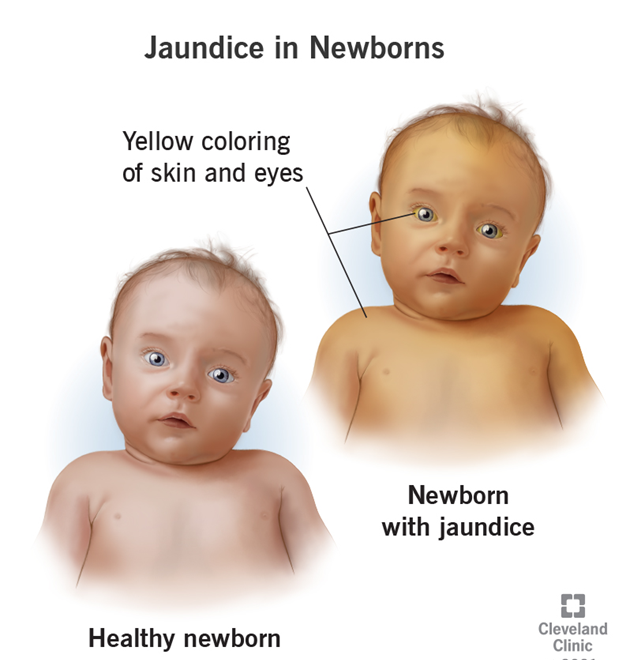The nurse is caring for a newly delivered breast-feeding infant. Which nursing intervention would best prevent jaundice in this infant?
Encouraging the mother to supplement breast-feeding with formula.
Keeping the infant NPO until the second period of reactivity.
Encouraging the mother to breastfeed the infant every 2 to 3 hours.
Placing the infant under phototherapy.
The Correct Answer is C
Choice A Reason:
Encouraging the mother to supplement breast-feeding with formula is not the best intervention to prevent jaundice. Frequent breastfeeding helps to increase the infant’s fluid intake and promotes the excretion of bilirubin through stools. Supplementing with formula may interfere with the establishment of breastfeeding and is not necessary unless the infant is not feeding well.
Choice B Reason:
Keeping the infant NPO (nothing by mouth) until the second period of reactivity is not recommended. Early and frequent breastfeeding is crucial in preventing jaundice as it helps to establish milk supply and promotes the passage of meconium, which contains bilirubin.
Choice C Reason:
Encouraging the mother to breastfeed the infant every 2 to 3 hours is the best intervention to prevent jaundice. Frequent breastfeeding ensures that the infant receives adequate nutrition and hydration, which helps to lower bilirubin levels by promoting regular bowel movements.

Choice D Reason:
Placing the infant under phototherapy is a treatment for jaundice, not a preventive measure. Phototherapy is used when bilirubin levels are already elevated. The goal is to prevent jaundice from developing in the first place through frequent breastfeeding.
Nursing Test Bank
Naxlex Comprehensive Predictor Exams
Related Questions
Correct Answer is D
Explanation
Choice A reason:
Drying the newborn with a warm blanket is an effective method to prevent heat loss through evaporation, not conduction. Evaporation occurs when moisture on the baby’s skin turns into vapor, which can cool the baby down. Using a warm blanket to dry the newborn helps to remove this moisture and keep the baby warm, but it does not specifically address heat loss via conduction.
Choice B reason:
Closing the doors to the delivery room helps to maintain a warm environment and prevent drafts, which can reduce heat loss through convection. Convection is the transfer of heat through air currents, and keeping the room warm can help to minimize this type of heat loss. However, this action does not directly address heat loss via conduction.
Choice C reason:
Wrapping the newborn in a blanket is another method to prevent heat loss through radiation and convection. By wrapping the baby, you create a barrier that helps to retain the baby’s body heat and protect against cooler air temperatures. While this is important for overall warmth, it does not specifically target heat loss via conduction.
Choice D reason:
Placing the newborn on a warm crib pad is the most effective method to prevent heat loss via conduction. Conduction is the transfer of heat from the baby’s body to a cooler surface. By using a warm crib pad, you ensure that the surface in contact with the baby is warm, thereby reducing the amount of heat lost through conduction. This method directly addresses the issue of heat loss via conduction and helps to keep the newborn warm.
Correct Answer is A
Explanation
Choice A reason:
Observing for meconium in respiratory secretions is crucial for newborns who are small for gestational age (SGA). Meconium aspiration syndrome (MAS) is a significant risk for these infants. Meconium, the first stool of an infant, can be passed into the amniotic fluid before or during labor, especially in cases of fetal distress. If the newborn inhales this meconium-stained fluid, it can lead to severe respiratory issues, including airway obstruction, inflammation, and infection. Therefore, careful monitoring and immediate intervention are necessary to prevent complications associated with MAS.
Choice B reason:
Monitoring for hyperthermia is not typically a primary concern for SGA infants. These infants are more prone to hypothermia due to their lower body fat and reduced ability to regulate body temperature. While maintaining a stable temperature is essential, the risk of hyperthermia is less common compared to hypothermia. Therefore, this intervention is not as critical as others for SGA infants.
Choice C reason:
Identifying manifestations of anemia is important but not the most immediate concern for SGA infants. Anemia can occur in these infants due to various factors, including intrauterine growth restriction and maternal conditions. However, the immediate postnatal period requires more urgent interventions, such as monitoring for respiratory distress and hypoglycemia. Anemia can be assessed and managed as part of the ongoing care plan.
Choice D reason:
Monitoring for hyperglycemia is not a primary concern for SGA infants. In fact, these infants are at a higher risk of hypoglycemia due to their limited glycogen stores and increased metabolic demands. Hypoglycemia can lead to serious complications, including neurological damage if not promptly addressed. Therefore, monitoring blood glucose levels and ensuring adequate nutrition are critical interventions for SGA infants.
Whether you are a student looking to ace your exams or a practicing nurse seeking to enhance your expertise , our nursing education contents will empower you with the confidence and competence to make a difference in the lives of patients and become a respected leader in the healthcare field.
Visit Naxlex, invest in your future and unlock endless possibilities with our unparalleled nursing education contents today
Report Wrong Answer on the Current Question
Do you disagree with the answer? If yes, what is your expected answer? Explain.
Kindly be descriptive with the issue you are facing.
